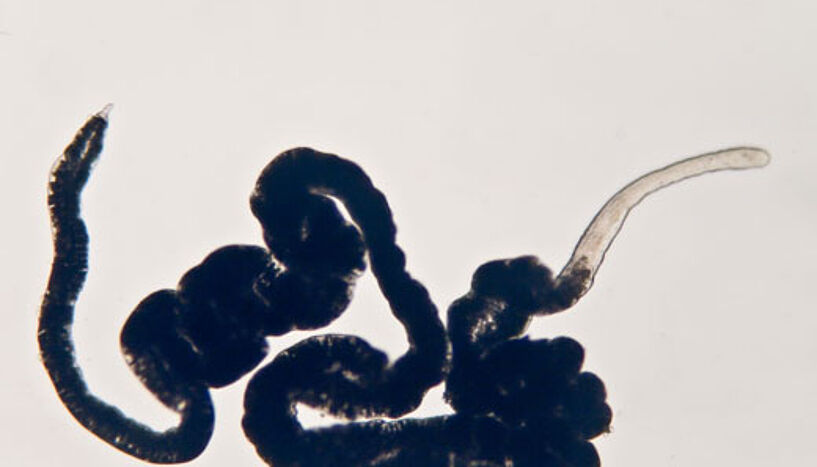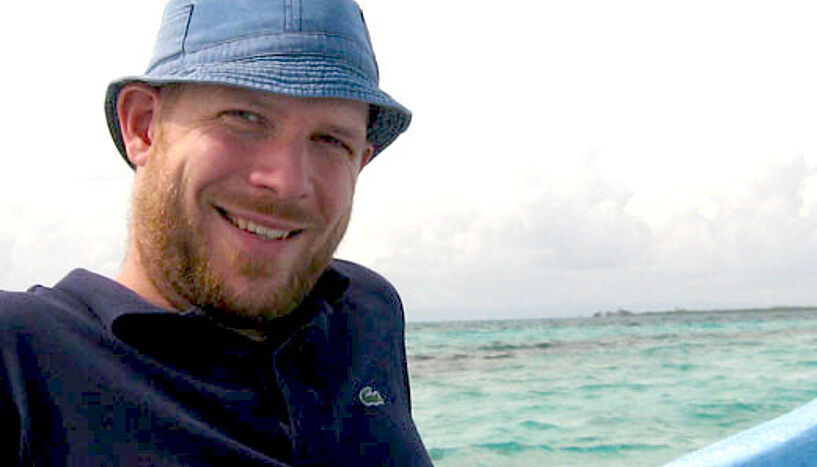Ancient symbiosis between animals and bacteria discovered - Marine biologists of the University of Vienna publish in PNAS
28. Juni 2011Marine shallow water sandy bottoms on the surface appear desert-like and empty, but in the interstitial space between the sand grains a diverse fauna flourishes. In addition to bacteria and protozoa numerous animal phyla have been found here, some only here. One of the strangest members of this interstitial fauna is Paracatenula, a several millimeters long, mouth and gut-less flatworm, which is found from tropical oceans to the Mediterranean. These worms are the focus of a research project led by Jörg Ott at the Department of Marine Biology of the University of Vienna with funding from the Austrian Science Foundation (FWF). The surprising results of this research have now been published in the journal "Proceedings of the National Academy of Sciences" (PNAS).
In the early 1970s, at the time of the discovery of Paracatenula, it was already a mystery how the worms acquire their food without a mouth and gut. The solution to this question came unexpectedly: At deep ocean hot vents, giant mouth-less tubeworms were found. These – like Paracatenula – live in symbiosis with intracellular bacteria that oxidize reduced sulfur compounds. The energy obtained in this chemical process is used by the symbionts to fix inorganic carbon into biomass – just like plants do using sunlight. Due to the high productivity of the symbionts, their hosts can derive all their nutrition from them.
Many animals of different phyla from several habitats have been found to live in such a symbiotic association. Compared to the great diversity of these hosts, the diversity of the microbial symbionts was strictly limited to members of only two classes, the Gamma and Epsilon Proteobacteria.
Paracatenula has Alpha-Proteobacterial "Riegeria" symbionts
One of the biggest surprises in the current study was that the symbionts of Paracatenula are indeed sulfur-oxidizing bacteria, but they are Alpha-Proteobacteria. Several other important intracellular symbionts come from this class, most notably the mitochondria, which are the crucial power plants in the cells of all higher organisms. The nitrogen-fixing root nodule bacteria of leguminous plants, as well as dangerous pathogens such as the causative agent of epidemic typhus, also belong to this class. In recent years several studies have presented evidence that the mechanisms in symbiotic and pathogenic relationships are similar or even identical. Future projects with Paracatenula and its symbionts called "Riegeria" could give fundamental insights into the mechanisms that have allowed Alpha-Poteobacteria several times to establish an intracellular lifestyle independently.
Another captivating detail of the Paracatenula Riegeria symbiosis is that the symbionts that live in specialized cells called Bacteriocytes account for up to 50 percent of the total tissue. That is significantly more than in all other known symbioses between animals and bacteria.
The Paracatenula-Riegeria symbiosis is 500 million years old
Based on genetic sequences of the symbionts the scientists have roughly extrapolated the age of the symbiosis – the estimated age of 500 million years makes this symbiosis the oldest known animal bacteria association.
Comparing the phylogenies of hosts and symbionts, another subtle but non trivial detail was uncovered – the worms have been passing on their symbionts to their offspring in every generation, without any symbiont switches for the last 500 million years. How this secured symbiont transmission is accomplished is the focus of the current studies in Jörg Ott’s lab.![]() Publication
Publication
Paracatenula, an ancient symbiosis between thiotrophic Alphaproteobacteria and catenulid flatworms: Harald Ronald Gruber-Vodicka, Ulrich Dirks, Nikolaus Leisch, Christian Baranyi, Kilian Stoecker, Silvia Bulgheresi, Niels Robert Heindl, Matthias Horn, Christian Lott, Alexander Loy, Michael Wagner, and Jörg Ott. In: Proceedings of the National Academy of Sciences (PNAS). June 27th, 2011.
Scientific Contact
Harald Gruber-Vodicka
Department for Marine Biology
University of Vienna
1090 Vienna, Althanstrasse 14
T +43-1-4277-571 04
harald.gruber(at)univie.ac.at
http://www.univie.ac.at/shallow-water-symbiosis/
Press Contact
Mag. Veronika Schallhart
Public Relations
University of Vienna
1010 Wien, Dr.-Karl-Lueger-Ring 1
T +43-1-4277-175 30
M +43-664-602 77-175 30
veronika.schallhart(at)univie.ac.at
Wissenschaftlicher Kontakt
Mag. Harald Gruber-Vodicka
(PhD Student) Department für MeeresbiologieUniversität Wien
1090 - Wien, Althanstraße 14
+43-1-4277-571 04
+43-699-171 219 09
harald.gruber@univie.ac.at
Rückfragehinweis
Mag. Veronika Schallhart
DLE ÖffentlichkeitsarbeitUniversität Wien
1010 - Wien, Universitätsring 1
+43-1-4277-17530
+43-664-8176793
veronika.schallhart@univie.ac.at
Downloads:
Paracatenula_urania_01.jpg
Dateigröße: 743,66 KB
Paracatenula_galateia_Video_01.m4v
Dateigröße: 6,29 MB
Harald_Gruber-Vodicka.jpg
Dateigröße: 1,95 MB


